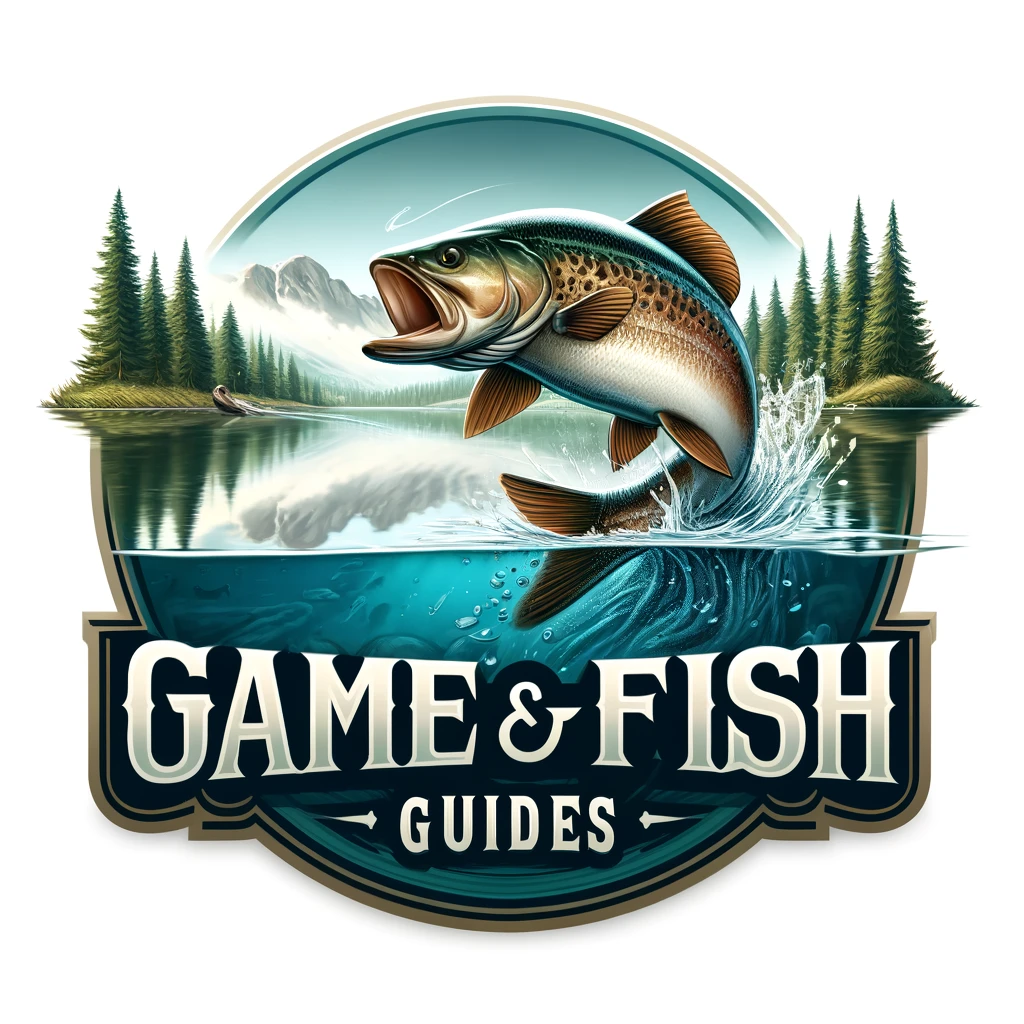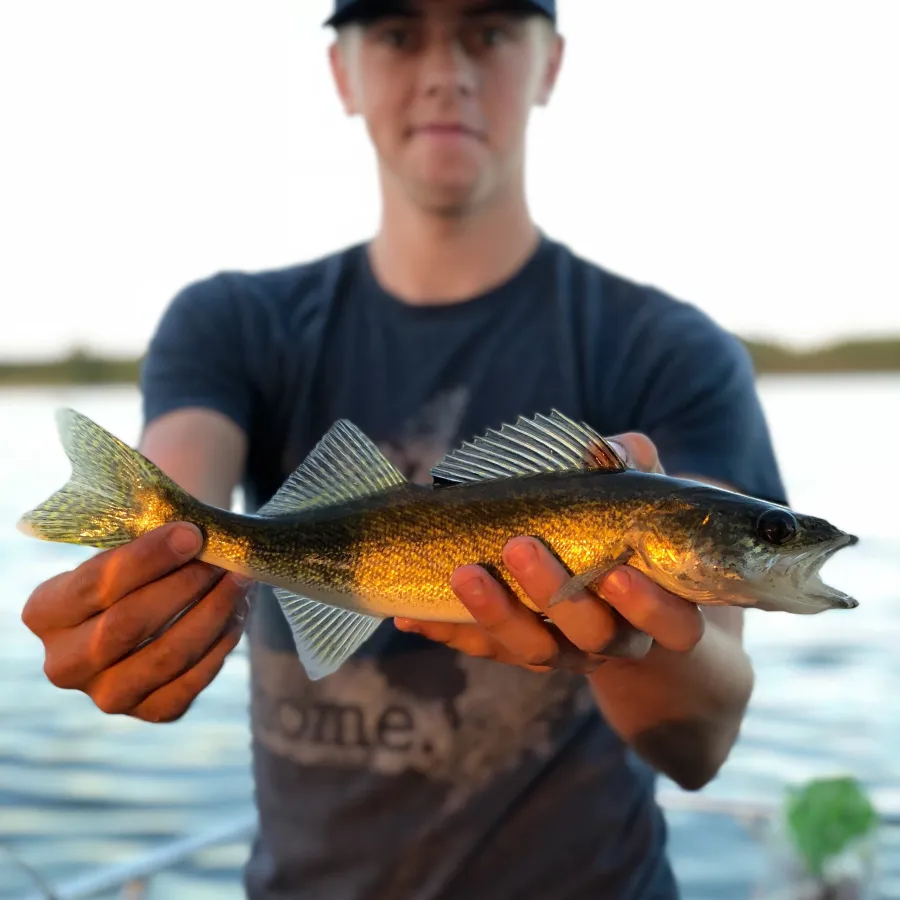If you came here looking for Walleye fishing tips, you’re in the right spot! In this article, we’re going to talk about what they look like, their behavior, and most importantly, how to catch them.
The walleye (Sander vitreus) is a popular freshwater fish species known for its taste, fighting ability, and distinct appearance. Walleye are highly sought after by anglers across North America, making them a popular target for both fun and sport fishing. Here’s a description of the walleye:
Appearance:
Walleyes have a distinctive appearance with large, glassy eyes that provide night vision and the ability to see well in dark or murky waters. Think of how insects’ eyes glow. They have a long slender body with a pointed snout.
The color of walleye can vary, ranging from olive-brown to a golden back, or a lighter yellowish color on the sides and belly. Dark vertical bands or markings on their sides give them a marbled look.
Size:
Walleye size varies depending on their habitat and food availability. They commonly range from 14 to 24 inches in length, with the ability to exceed 30 inches, although rare. The weight of walleye varies, with fish weighing 1 to 3 pounds being common, and trophy-sized fish weighing upwards of 10 pounds.
Habitat:
Walleye are found in a variety of freshwater environments such as lakes, reservoirs, rivers, and large streams. They prefer areas with cover such as submerged rocks, underwater structures, and drop-offs.
Behavior and Diet:
Walleye are predatory fish and primarily feed on smaller fish, such as minnows and perch, as well as aquatic insects and crustaceans. They are known for their feeding activity during low-light conditions, making them particularly active during dawn and dusk.
How to catch Walleye:
Catching walleye can be a rewarding yet challenging endeavor. These fish are known for their elusive behavior and specific preferences. Here are some Walleye fishing tips and techniques to help you catch walleye:
1. Choose the Right Tackle:
The best walleye rod will often depend on your specific fishing conditions, but generally, you’ll want something that’s sensitive enough to feel the bite but strong enough to handle a feisty walleye. A medium-light to medium power rod with a fast action is usually a good pick. This will give you the sensitivity to detect those soft walleye bites and the strength to haul in your catch. You’ll also want to consider the length based on your fishing style. A longer rod, say around 7 feet, is generally better for casting, while a shorter rod works well for jigging.
The best line for walleye can vary depending on your fishing situation, but here are some general tips. Monofilament line is a popular choice because it’s versatile and affordable. It’s also fairly invisible underwater, which is great for those finicky walleye. However, it does stretch, which can be a downside when you need sensitivity.
Fluorocarbon is another good option. It’s nearly invisible underwater and doesn’t stretch as much as monofilament, giving you better sensitivity to feel those subtle bites. But it’s usually more expensive.
Braided line is super strong and has no stretch, which makes it very sensitive. This can be a big advantage when jigging. However, it’s more visible in the water, so it’s often best used with a fluorocarbon or monofilament leader.
So, the best line really depends on your technique and the water you’re fishing in. If you’re trolling, you might opt for a braided line for its strength and sensitivity. If you’re casting and retrieving, monofilament or fluorocarbon could be the better choice.
2. Choose the Right Location:
Look for areas with cover and structure, such as submerged rocks, points, drop-offs, underwater ledges, and weed edges. These are popular spots where walleye hide and ambush prey.
3. Depth and Temperature:
Pay attention to the water temperature and depth. Walleye tend to be in shallower waters during the spring and fall and move to deeper waters in the heat of summer. Use a fishfinder to locate the right depth based on the season and water conditions.
4. Use Live Bait:
Live bait such as minnows, nightcrawlers, and leeches are effective for enticing walleye. Hook the bait through the back to allow for natural movement in the water.
5. Jigging for walleye
Jigging is a popular method for catching walleye. Use a jig with a live bait or soft plastic tail. Maintain a slow and deliberate jigging motion, often involving short lifts and pauses to mimic the movement of prey.
6. Trolling for walleye
Trolling with crankbaits, spinner rigs, or worm harnesses can be effective for covering larger areas and locating active fish. Vary your trolling speed to find the right presentation that triggers strikes.
7. Best Lures for Walleye:
The best walleye lures can change based on a bunch of stuff like where you’re fishing, the time of year, and even the time of day. But, here are some lures that are usually super effective for catching walleye:
- Crankbaits: These are killers for covering a lot of water fast. Great for trolling and they come in a bunch of depths and colors.
- Jigs: Probably the most classic and versatile walleye lure. You can tip it with live bait or use it with a soft plastic tail.
- Spinner Rigs: These are awesome when the walleye are a little finicky. Tip it with a minnow or a nightcrawler and you’re in business.
- Spoons: These are a top choice when you’re trolling deep water. They mimic a dying fish when they wobble, and walleye can’t resist that.
- Soft Plastics: These can be great, especially when you rig them on a jig head. They’re super for mimicking all sorts of prey, from fish to bugs.
Remember, color and size can be super important too. Some days walleye want something bright like chartreuse or orange, and other days they might want something more natural-looking. So, it’s a good idea to have a variety of these lures in your tackle box.
8. Drifting and Slow-Trolling:
Drifting with live bait or slow-trolling with crawler harnesses can be productive, especially in areas with some current.
Walleye fishing tips
You’ve made it to the end of our walleye guide, and you’re now armed with all the knowledge you need on how to fish for walleye. From choosing the right spots to understanding their behavior, we’ve covered it. But don’t forget, the gear you use can make or break your trip. And if you’re wondering what to fill your tackle box with, we’ve also laid out the best walleye lures to help you get those bites. So get out there, cast your line, and catch some Walleye!

